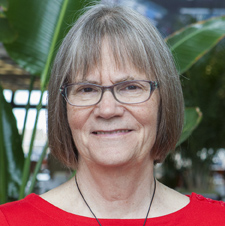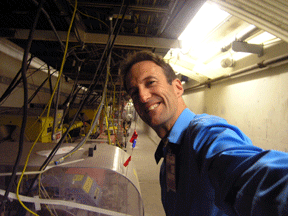2019 Annual Report

QuarkNet
Fermilab: University of Chicago
Parameterization of Flux Graphs

Emi Ahlo - Kamehameha Schools Kapalama, Honolulu, HI
Using flux graphs, the reliability of a Student Cosmic Ray Detector can be identified. Analysis of
numerous detectors with a variety of geometry and parameters have produced specific detector data
characteristics that identify reliable detectors. The two most telling properties are a horizontal best fit
line in the flux plots, and no more than 15% of a deviation from that line.
Altitude vs. Muon Lifetime

Kahiwakuikanaulu Hoe - Kamehameha Schools Kapalama
In order to analyze the relationship between muon decay time and elevation from sea level, muon
detectors from around the world were reviewed for accuracy. The amount of flux and the consistency of
the detector were the primary factors to monitor, and the lifetimes of each school along with its
respective elevation were plotted to show a positive correlation between 40 m and 240 m of elevation,
but higher altitudes had too few data points to draw a notable conclusion.
Cosmic Shower Parametrization and CME Hazard Prognosis

John Mailolo - Kamehameha Schools Kapalama
Cosmic showers are a natural event caused by radiation, which may produce negative and mutagenic
effects within human populations. This study defines the parameterization to measure and detect
increased levels of cosmic radiation, utilizing solar flare data first, then flux levels.
In addition to parametrization, this methodology predicts a correlation with cosmic radiation on Earth,
within one to three days. This parameterization also highlights the potential boundaries at which solar
Comparing EUV and LOS Magnetic Field Images to Determine if Coronal Holes are a Part of the Solar Cycle

Zain Jabbar - Maui High School
Hydroponic System Simulation of UVC Effects on Plant Growth for Mars

OneJae Lee – Maui High School
Constructing a Raspberry Pi Muon Detector

Mary Chin - Maui High School
Student abstract information for HS internships at WIPAC/UW–Madison

Vetal, a multimessenger online analysis tool
Haley James and Elsa Forberger (West High School), Blake Gallay (Middleton High School)
Amanda Nothem (Whitnall HS)
Josh Wood and Sílvia Bravo (WIPAC)
The purpose of our research was to develop an online tool to analyze pubic data sets from IceCube and FermiLAT. The goal was to facilitate multimessenger astronomy analyses targeting both scientists and amateur researchers.
How long-baseline neutrino experiments, like MINOS, analyze detector data to extract neutrino oscillation parameters

2015 Summer QuarkNet MINOS Research Project
Theodore Baker (Walnut Hills High School)
Panos Manganaris (Anderson High School)
Mentor Alex Sousa
The purpose of my research this summer was to understand how long-baseline neutrino experiments, like MINOS, analyze detector data to extract neutrino oscillation parameters. By utilizing the ROOT Data Analysis Framework, I first learned basic properties and differences of different types of neutrino interactions through Monte Carlo (simulated) data. Neutrinos interact with other subatomic particles through the weak force. Charged current (CC) interactions occur when a neutrino of any flavor converts to its partner charged lepton (e.g.) through exchange of a boson. Neutral Current (NC) interactions take place when a neutrino interacts with a Z0boson yet does not convert into a charged lepton. Unlike CC events observed in the detector, NC events all look the same no matter the neutrino flavor and therefore are insensitive to neutrino oscillations and are removed from the oscillation analysis. I developed a selection method based on the event length of separate NC and CC events. I then fit the MINOS data reconstructed energy spectrum to a Monte Carlo spectrum oscillated with different sets of values for the oscillation parameters. The best-fit value for sin( Ø23 ) is almost 1 and the best-fit parameter for Δm2/23 is 0.0022, closely matching the MINOS published results. The study of these neutrino oscillations could potentially help us solve the long-standing puzzle of matter-antimatter asymmetry.
Identifying signal and background events in decay channels of D*+

2015 Summer Quarknet LHCb Research Project
Akshansh Gupta (Walnut Hills High School)
Bridget Sypniewski (Mount Notre Dame High School)
Mentor Mike Sokoloff
The purpose of the LHCb work we did was to find signal regions and values from unedited, unclean information sets of different type of particle decays. Several decays were looked at and evaluated throughout the program, including Lambda decays, Dbar decays, and Dstar decays, and multiple Dplus decays. Information on these decays was supplied from LHC. In these decays, there were different intensities of entries. Consistent underlying intensity could be regarded as background, while intensity that peaked particularly high in only a specific location was regarded as signal. The goal for each situation was to find a signal in this information, and to reduce the amount of background so that the signal could be clearly seen and defined, however, in the process of reducing the background, in order to avoid losing any signal value, on occasion, background was still left in the final product. For each decay, several variables were used, such as flight distance and lifetime. These were often used to help discriminate between signal and background on the mass, and occasionally, vice versa. Evaluations were done through the use of TMVA analysis, background subtractions, and discrimination tests. These evaluations were successful at separating a signal from the background for the information given for the decays evaluated, and were generally accurate and similar to established information. The information found in my work will be later passed on to other scientists and students to do further analysis on, as well as evaluated some of the information collected from the LHC and turned raw data into a cleaner more edited format for further use and evaluation.